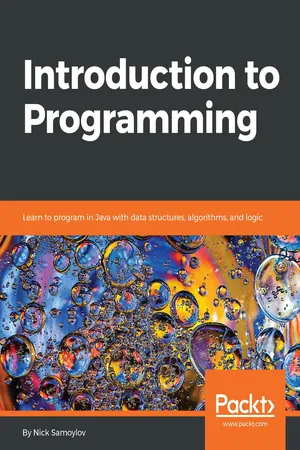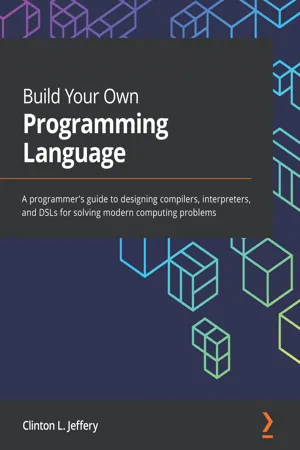Computer Science
Java Syntax
Java syntax refers to the set of rules that define how Java programs are written and interpreted. It includes rules for writing statements, expressions, variables, methods, classes, and other program elements. Proper use of Java syntax is essential for creating functional and efficient Java programs.
Written by Perlego with AI-assistance
Related key terms
3 Key excerpts on "Java Syntax"
- eBook - ePub
Introduction to Programming
Learn to program in Java with data structures, algorithms, and logic
- Nick Samoylov(Author)
- 2018(Publication Date)
- Packt Publishing(Publisher)
Java Language Basics
Now that you have a general idea about Java and its related terms and tools, we will start discussing Java as a programming language.This chapter will introduce the basic concepts of Java as an object-oriented programming (OOP ) language. You will learn about classes, interfaces, and objects, and their relations. You will also learn the concepts and features of OOP.In this chapter, we will cover the following topics:- The basic terms in Java programming
- Classes and objects (instances)
- Class (static) and object (instance) members
- Interface, implementation, and inheritance
- OOP concepts and features
- Exercise – Interface versus abstract class
We call them basics because they are the founding principles of Java as a language, and there is more to learn before you can start programming professionally. For those who are learning Java for the first time, learning the basics of Java is a steep slope to climb, but the path becomes easier thereafter.Passage contains an image
The basic terms of Java programming
The notion of Java programming basics has many interpretations. Some tutorials assume the basics to be the same for any object-oriented language. Others discuss syntax and basic language elements and grammar rules. Yet others reduce the basics to the value types, operators, statements, and expressions that allow computations.Our view of Java basics consists of some elements from each of the earlier approaches. The only criteria for the selection we used were practicality and a gradual increase of complexity. We will start with simple definitions in this section, and then dive deeper into them in the subsequent sections.Passage contains an image
Byte code
In the broadest terms, a Java program (or any computer program for that matter) means a sequential set of instructions for a computer, that tell it what to do. Before executing on a computer, a program must be compiled from a human-readable, high-level programming language into a machine-readable binary code. - eBook - ePub
- Jarryd Huntley, Hanna Brady(Authors)
- 2017(Publication Date)
- A K Peters/CRC Press(Publisher)
Each family of programming languages and each language has its own syntax and rules. As with spoken languages, once you learn a first programming language you’ll have an easier time learning a second from the same family. Along with that, once you learn one programming language—from any family—learning any other programming language becomes much easier. The process changes from learning all the rules and vocabulary from scratch to picking up the subtle and not-so-subtle differences from the other languages you know.Again, as with spoken languages, different programming languages can be used to express the same ideas. Each programming language has its own specific rules, so the ideas will be constructed differently, some more or less efficiently, but they will all get the job done.C# and C++In most human languages, syntax is the proper or elegant arrangement of words into sentences. In programming languages, syntax refers to the rules of writing code in such a way that it’s understood by the computer. Syntax is the code for writing code.In this book, we’ll be focusing on the programming languages: C# (read as C sharp), We’ll briefly look at C++ (read as C plus plus), and JavaScript.C#, C++, and JavaScript come from the same family of programming languages, referred to as C-like Programming Languages. These are popular languages for general programming and for game programming.C# is newer and could be considered a descendent from C++. They share a lot of the same syntax, rules, and feel. They are, however, used in fairly different ways.C++ is an extremely powerful programming language. It gives you virtually unlimited options. Very few programming languages can match C++ in its speed and power. The main downside to C++ is its complexity. It can be a relatively difficult programming language to learn. Along with all that power comes a great deal of syntax, many considerations to keep in mind, and techniques to master. Unreal, id Tech, Source and Crytek are all game engines built in C++.JavaScriptJavaScript is one of the most popular programming languages, and it shares some syntax with C# and C++. The big difference between the two is that JavaScript is a web programming language, and its interpreters are built into your browser. When programming games for the web, JavaScript is your first and best option. - eBook - ePub
- Clinton L. Jeffery(Author)
- 2021(Publication Date)
- Packt Publishing(Publisher)
Once you have worked out what the individual words and punctuation in your language should be, you can work your way up to larger constructs. This is the transition from lexical analysis to syntax, and syntax is important because it is the level at which bits of code become large enough to specify some computation to be performed. We will look at this in more detail in a later chapters, but at the design stage, you should at least think about how programmers will specify the control flow, declare data, and build entire programs. First, you must plan for the control flow.Specifying the control flow
The control flow is how the program's execution proceeds from place to place within the source code. Most control flow constructs should be familiar to programmers who have been trained in mainstream programming languages. The innovations in your language design can then focus on the features that are novel or domain-specific and that motivate you to create a new language in the first place. Make these novel things as simple and as readable as possible. Envision how those new features ought to fit into the rest of the programming language.Every language must have conditionals and loops, and almost all of them use if and while to start them. You could invent your own special syntax for an if expression, but unless you've got a good reason to, you would be shooting yourself in the foot. Here are some control flow constructs from Java that would certainly be in Jzero:if (e) s; if (e) s1 else s2; while (e) s; for (…) s; Here are some other less common Java control flow constructs that are not in Jzero. If they were to appear in a program, what should a Jzero compiler do with them? switch (e) { … } do s while (e);By default, our compiler will print a cryptic message that doesn't explain things very well. In the next two chapters, we will make our compiler for Jzero print a nice error message about the Java features that it does not support.Besides conditionals and loops, languages tend to have a syntax for calling subroutines and returning afterward. All these ubiquitous forms of control flow are abstractions of the underlying machine's capability to change the location where instructions are executing – the GOTO. If you invent a better notation for changing the location where instructions are executing, it will be a big deal.
Index pages curate the most relevant extracts from our library of academic textbooks. They’ve been created using an in-house natural language model (NLM), each adding context and meaning to key research topics.


